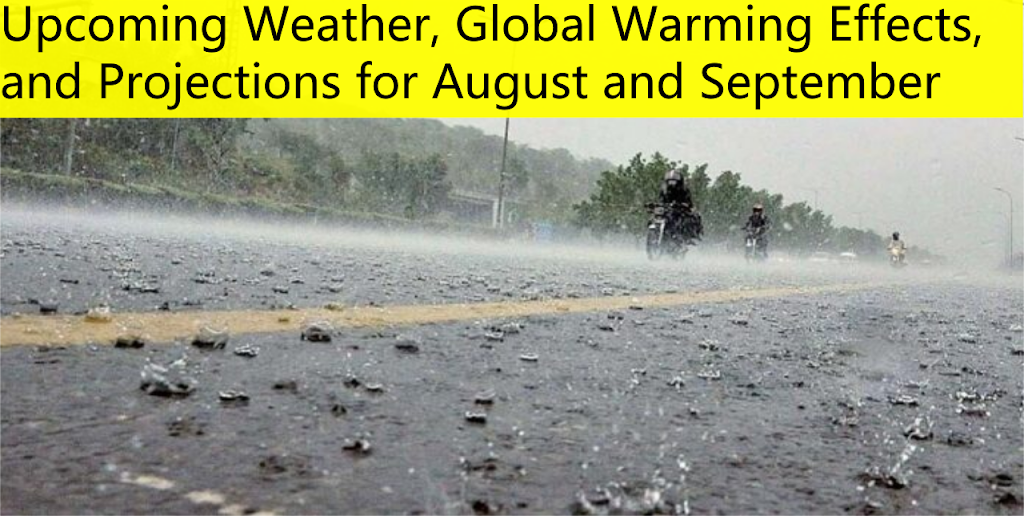 |
| weather-pakistan-swaat-valley |
As we move through the summer months, the weather patterns around the world are undergoing significant changes. With the pressing issue of global warming, these changes are becoming more unpredictable and extreme. This article will explore the upcoming weather for August and September, delve into the effects of global warming on our climate, and discuss what we might expect in the near future.
Upcoming Weather for August and September
In August and September, the Northern Hemisphere typically transitions from the peak of summer to the early signs of autumn. However, this year, we are likely to see some notable deviations from the norm.
North America: The United States and Canada have experienced an unusually hot summer, and this trend is expected to continue into August. The Pacific Northwest, which faced a record-breaking heatwave in July, might see some relief, but temperatures are still anticipated to be above average. The Midwest and Eastern regions of the US could experience more frequent thunderstorms, potentially leading to localized flooding. As September approaches, the Gulf Coast and Southeastern states should remain vigilant for hurricanes, as the peak of the Atlantic hurricane season occurs in these months.
Europe: Europe has also been grappling with extreme heatwaves, particularly in Southern Europe. August is expected to bring more scorching temperatures to countries like Spain, Italy, and Greece. In contrast, Northern Europe might see a mix of warm days and sudden rain showers. September could bring some respite with cooler temperatures and the possibility of early autumn rains, particularly in the UK and Scandinavia.
Asia: Monsoon season will continue to dominate the weather in South Asia. India, Pakistan, and Bangladesh are likely to experience heavy rainfall, which can lead to flooding in certain areas. East Asia, including China and Japan, might face a mix of typhoons and heatwaves. In Southeast Asia, countries like Indonesia and the Philippines should prepare for tropical storms, especially in September.
Australia and New Zealand: As these regions move towards spring, Australia might see an increase in bushfire risks, especially in the southeastern parts. New Zealand is expected to experience a mix of mild temperatures and occasional rain showers.
Global Warming and Its Impact
The influence of global warming on our weather patterns cannot be overstated. Human activities, particularly the burning of fossil fuels, have led to an increase in greenhouse gases in the atmosphere. This has resulted in a rise in global temperatures, which in turn affects weather systems worldwide.
Heatwaves: One of the most direct impacts of global warming is the increase in the frequency and intensity of heatwaves. This summer, many parts of the world have experienced unprecedented temperatures, leading to severe health issues, wildfires, and agricultural losses. For example, the heatwave in the Pacific Northwest of the US saw temperatures soaring above 110°F (43°C), a previously unimaginable figure for the region.
Storms and Hurricanes: Warmer ocean temperatures contribute to more intense and frequent storms. The Atlantic hurricane season has been more active in recent years, with storms gaining strength more rapidly. This year is no exception, and August and September are likely to see several major hurricanes forming in the Atlantic.
Flooding: Increased temperatures lead to more evaporation and, consequently, more precipitation in certain areas. This can result in severe flooding, as seen in parts of Europe and Asia this year. The recent floods in Germany and Belgium were some of the worst in decades, highlighting the growing risk of such events.
Droughts and Wildfires: While some areas receive excessive rainfall, others face prolonged droughts. This is particularly evident in regions like the Western US and parts of Australia. Drought conditions not only threaten water supplies but also create ideal conditions for wildfires. The wildfires in California and Australia have caused significant damage, emphasizing the urgent need for climate action.
Projections for the Future
As we look ahead to August and September, the forecast suggests that we will continue to see the effects of global warming on our weather patterns.
Heatwaves and High Temperatures: Expect continued high temperatures in many parts of the world, particularly in the Northern Hemisphere. Governments and communities should prepare for potential health crises and infrastructure challenges caused by prolonged heat.
Storm Activity: The Atlantic hurricane season will likely remain active, with the potential for several major storms. Coastal communities should remain alert and have emergency plans in place.
Rainfall and Flooding: South Asia will continue to experience heavy monsoon rains, with the risk of flooding in low-lying areas. Europe and East Asia might see sporadic heavy rains, which could lead to localized flooding.
Wildfires: Regions prone to drought, such as the Western US and parts of Australia, should brace for an increased risk of wildfires. Preventative measures and readiness plans are crucial to mitigate the impact.
In conclusion,
the upcoming weather for August and September is expected to be marked by extremes, driven largely by the ongoing effects of global warming. As our climate continues to change, it is imperative that we adapt and take action to mitigate these impacts. Whether through better preparedness for natural disasters or efforts to reduce greenhouse gas emissions, the time to act is now. The future of our planet depends on the choices we make today.
